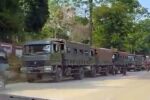TAIPEI, Taiwan – South Korea said it’s considering setting up a “necessary facility” in overlapping territorial waters with China in the Yellow Sea as a countermeasure to Beijing’s installation of a steel structure in the area.
South Korean media reports say the structure, which is 50 meters (164 feet) in both height and diameter, is the latest of three Chinese installations in the waters. Beijing has said all the structures are for aquaculture.
“Regarding the proportional measure, we are taking this matter very seriously from the perspective of protecting our maritime territory,” said South Korea’s oceans minister Kang Do-hyung on Monday, adding that the government first has to decide “what kind of facility is necessary at which level.”
“We are strongly protesting to China through diplomatic channels. We view this matter with utmost seriousness, given its importance and our position on protecting our maritime territory,” said Kang.
Kang’s remarks came after media reported that the disputed structure is an old oil rig that was used in the Middle East.
The structure, equipped with a helipad, has “Atlantic Amsterdam” written on its surface, which is the name of an oil rig built by France in 1982, Seoul-based daily Chosun Ilbo reported on Monday.
South Korea and China’s overlapping claims to areas of the Yellow Sea are managed under a provisional measures zone, or PMZ, intended to prevent conflict between the two states.
Chinese foreign ministry spokesperson Guo Jiakun on Monday reiterated that the structure was for aquaculture.
“The aquaculture facilities set up by a Chinese company in the PMZ do not contravene the agreement between China and the ROK,” said Guo, calling South Korea by its official name, Republic of Korea.
“China has shared relevant information and maintained communication with the ROK through channels such as the dialogue and cooperation mechanism of maritime affairs. We hope the ROK will view this in an objective and reasonable manner,” he said.
A Chinese-South Korean agreement that established the PMZ in 2001 allows fishing vessels from both countries to operate within the zone. It prohibits any activity beyond navigation and fishing.
Despite the agreement, China has reportedly installed several large steel structures, including two in April and May of last year, and another this year, raising concerns in South Korea over potential territorial disputes.
In February, the two countries had a tense maritime standoff as Chinese authorities blocked Seoul’s attempt to investigate Beijing’s steel structure near Ieo Island, off South Korea’s southwest coast.
Analysts say China has employed a deliberately incremental strategy in waters it seeks control over, including the South China Sea – gradually advancing its territorial claims through low-level actions that avoid outright conflict but steadily alter the status quo.
This includes building artificial islands on features such as Cross Reef and Mischief Reef, deploying coast guard and maritime militia vessels near contested areas such as Scarborough Shoal and Second Thomas Shoal, and installing military facilities including runways, missile systems and surveillance radars on reclaimed land.
Edited by Mike Firn and Stephen Wright.








